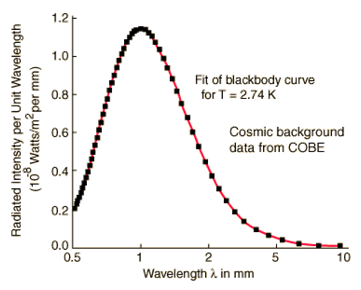-
Paper Information
- Paper Submission
-
Journal Information
- About This Journal
- Editorial Board
- Current Issue
- Archive
- Author Guidelines
- Contact Us
International Journal of Astronomy
p-ISSN: 2169-8848 e-ISSN: 2169-8856
2013; 2(2): 17-22
doi:10.5923/j.astronomy.20130202.01
Cosmology with the Cosmic Microwave Background
1Department of Physics, University of Kashmir, Hazratbal, 190006, Srinagar, J&K, India
2Inter-University Centre for Astronomy and Astrophysics, Ganeshkhind, Pune, India
Correspondence to: Manzoor A. Malik, Department of Physics, University of Kashmir, Hazratbal, 190006, Srinagar, J&K, India.
| Email: |  |
Copyright © 2012 Scientific & Academic Publishing. All Rights Reserved.
Cosmic Microwave Background is credited with bringing out Cosmology from Speculation to Precision Science. Many of the key cosmological parameters like its age (13.75 Billion Years), its composition (4.6% Baryons, 22.7% Dark Matter, 72.8% Dark Energy) and curvature (flat) are now known to a high degree of accuracy (sub-percent to percent level). It not only provides a more acceptable basis for the Big Bang Model but also gives an observational basis to the formation of structures that we see in the present Universe, ruling out many cosmological models. In this paper, I intend to review as to what we have learnt from the cosmic microwave background and what we expect to learn from it in future, in light of the recent (and upcoming) experimental/observational and theoretical advances.
Keywords: Cosmic Microwave Background, Anisotropies, COBE, WMAP, PLANCK
Cite this paper: Manzoor A. Malik, Cosmology with the Cosmic Microwave Background, International Journal of Astronomy, Vol. 2 No. 2, 2013, pp. 17-22. doi: 10.5923/j.astronomy.20130202.01.
Article Outline
1. Introduction
- Cosmic Microwave Background (CMB) provides a snapshot of the Universe when it was barely 0.3 million years old i.e. long before stars or galaxies ever existed. CMB is thus the present day relic of the remnant radiation from the big bang. By studying the detailed physical properties of CMB radiation, we can learn about conditions in the Universe on very large scales at very early times. It also provides clinching evidence in support of the Big Bang theory. Measurement of the temperature fluctuations (anisotropies), at the level of 1 part in 105, by COBE (Cosmic Background Explorer)[1] and vastly improved by the WMAP (Wilkinson Microwave Anisotropy Probe)[2-5] and scores of ground and balloon based experiments (list of ongoing and future ground-based and balloon-borne CMB temperature and polarization experiments can be found in[6]) have addressed some of the key questions in cosmology. The relatively recent discovery of the presence of anisotropies in the CMB’s polarization pattern[7], even though fainter than the temperature anisotropies, carry valuable additional information. This information is encoded in about a dozen cosmological parameters, each of which describes a basic property of the Universe. Some of these parameters like the age of the Universe(13.73 billion years), curvature of space (flat), the average density of baryonic matter (0.0449±0.0028), dark matter (0.222±0.026) and dark energy (0.734±0.029) have been determined to around 1% accuracy by WMAP. The comprehensive list of the 7-year WMAP cosmological parameters can be found in[2].Rapid advances in observational cosmology are leading to the establishment of the first precision cosmological model, with many of the key cosmological parameters like the matter density, Hubble constant, spatial curvature etc., determined to one or two significant figure accuracy. Besides being consistent with previous results, the new 7-year WMAP data[2-5] has improved due to reduced noise from the additional integration time, improved knowledge of the instrument performance, and improved data analysis. The seven year data set is well fit by a minimal six-parameter flat Lambda-CDM model. Finally, Planck (a satellite mission launched by the European Space Agency) is expected to perform the ultimate measurement of primary CMB temperature anisotropies and to disseminate valuable information about the CMB polarization. These advances, particularly in the last two decades, have brought out cosmology from speculation to precision science.
2. Discovery and Early History
- The credit for first prediction of the CMB radiation goes to Alpher, Herman, and Gamow[8]. They predicted that a Big Bang Universe will have a black body cosmic microwave background with a temperature around 50 K. This was later recalculated (pointing some errors in the earlier calculation) by Alpher and Herman[9] to show that the CMB temperature is around 5 K. Many astronomers credit the discovery of CMB to McKeller, who as early as 1941[10] had used the excitation of CN doublet lines to deduce that the effective temperature of the space is around 2.3 K. However, this paper received less attention. Back in 1937, Dunham and Adams while studying the properties of CN in the interstellar medium observed that CN was excited as if it was immersed in a thermal bath of radiation of temperature T~3K. Again, nobody realized the importance of this work at that point. In 1957, Shamaonov[11] had reported that the absolute effective temperature of the radio emission background (now known as CMB) to be around 4K. Their measurements showed that the radiation intensity was independent of either the time or the direction of observations. This work also went almost unnoticed. In the literature, we find a number of near misses which could all have been treated as a discovery of CMB.In 1964, two radio astronomers, Penzias and Wilson began their search to detect sources of radiation that might potentially harm satellites. To their frustration, they found a uniform signal in the microwave range, seeming to come from all directions. Having no clue what it was, they tried everything to eliminate this “unwanted” background noise but failed. Luckily, Penzias talked to Burke, a scientist at MIT, who advised him to talk to Bob Dicke at Princeton. When the phone call ended, Dicke is reported to have told his colleagues “Boys, we have been scooped”. This was because Bob Dicke and his collaborators (including Dave Wilkinson after whom WMAP was later named) were precisely looking for the signal that was an unwanted noise for Penzias and Wilson and were almost ready with an experiment to find the CMB. CMB had been discovered by Penzias and Wilson! The spectrum of CMB fitted a nearly perfect black body with its temperature at around 3K. The experimental results of Penzias and Wilson[12] detailing the observation and the cosmological interpretation by Dicke, Peebles, Roll and Wilkinson[13] were published side by side in the Astrophysical Journal. For their discovery, Penzias and Wilson, were awarded the 1978 Nobel prize in Physics. Following the serendipitous discovery of the CMB, the next step was to look for the anisotropies in the CMB. Early attempts limited by the low sensitivity of instruments, indicated that CMB was discouragingly smooth. Many experiments were designed to look for the characteristics of CMB but the real breakthrough came with the COBE mission’s confirmation of the perfect black body spectrum of the CMB and the small (1 part in 105) but significant anisotropies in the cosmic microwave background. John Mather and George Smoot shared the 2006 Nobel prize in Physics for their discovery of the blackbody form and anisotropy of the cosmic microwave background radiation respectively.
3. Satellite Missions
- Hundreds of ground based and balloon borne experiments have been performed to characterize the CMB and some of those experiments have yielded noteworthy results. A comprehensive list of these experiments can be found at wikipedia[14]. The reason we are focusing here on the satellite missions only is that observations from space are neither affected by atmospheric effects nor by emissions from the Earth’s surface. Further, space missions offer an excellent degree of thermal stability and allow the entire sky to be covered.Three satellite missions have been launched so far to study the cosmic background radiation. The first of these was the COBE (Cosmic Background Explorer) followed by the WMAP (Wilkinson Microwave Anisotropy Probe) both of which were NASA CMB missions. The latest (with the highest angular resolution and sensitivity) has been launched by the European Space Agency (ESA) and is still in orbit. We shall briefly discuss the science outcome of each of these missions.
3.1. COBE
- As early as in 1976, a committee at NASA had recommended launching of a satellite called COBE (COsmic Background Explorer) to measure the diffuse infra-red and the cosmic microwave background radiation from the early universe. The satellite mission would contain three major instruments: DMR (Differential Microwave Radiometer) that would map anisotropies in the CMB, FIRAS (Far Infrared Absolute Spectrophotometer) that would measure the spectrum of CMB and DIRBE (Diffuse Infrared Background Experiment) that would map dust emission. For many reasons the project got delayed and the COBE satellite was finally launched in 1989. During this time (1976-89), many significant developments had been made. This included simultaneous detection of the quadrapole distribution of CMB using balloon-borne instruments by Uson and Wilkinson et al[15] and Melchiorri et al[16]. Wilkinson and his group performed a series of studies looking for dipole and quadrapole anisotropy at small as well as large scales[14],[17],[18], all preceding the launch of COBE satellite. Detection of intermediate angular scale anisotropies at the level of 100 micro Kelvin was claimed by Melchiorri et al earlier[16]. These findings, however, could not be verified although various other experiments were designed for the purpose (see e.g. Leverington[19] for details).
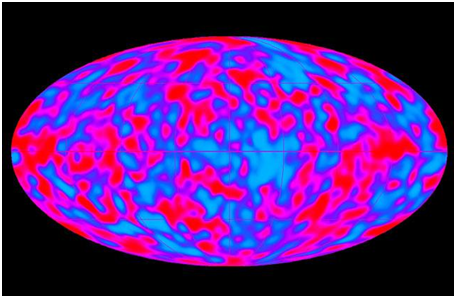 | Figure 1. COBE map of the CMB (Figure credit: NASA science team) |
3.2. WMAP
- Although COBE’s discoveries confirmed the theory of Big Bang and provided important information about the origin of the universe, it had a poor sensitivity and angular resolution (7o) by today’s standards. To complement the observations of COBE and to study the properties of Universe as a whole, NASA launched a subsequent satellite mission WMAP in 2001. The mission successfully completed in 2010 although the data is still being analysed. WMAP had a sensitivity 45 times and an angular resolution 33 times that of COBE leading to results that are unprecedently precise. Such was the impact of WMAP findings that in 2011 the three most highly cited papers in all of Physics and Astrophysics were all WMAP scientific papers. Earlier releases in 2009[20-21], 2007[22-23] and 2003[24] had received a similar overwhelming response.
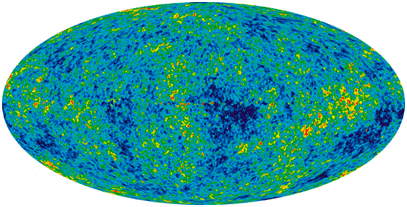 | Figure 2. A high resolution foreground cleaned CMB map from WMAP. Red regions are warmer and blue regions are colder by about 0.0002 degrees (Figure credit: NASA science team) |
3.3. PLANCK
- Planck mission, named after Max Planck, was launched in May 2009 by the European Space Agency (ESA) with the objective of attaining the highest precision, highest resolution and the cleanest CMB maps. With an improved angular resolution (3 times that of WMAP) enhanced sensitivity (more than 5 times that of WMAP), lower noise at the optimal frequency band and wide frequency coverage, it will measure all of the temperature information in the CMB and a substantial portion of the polarization information unknown with WMAP. Having recently completed 5 full sky surveys with its instruments HFI (High Frequency Instrument) and LFI (Low Frequency Instrument), Planck has not only mapped the primodial microwaves from the Big Bang but also has seen emission of cold dust throughout the universe. The early Planck results announced in 2011 include a catalogue of Galaxy Clusters in the distant universe, possible merging clusters, measurement of an infra-red background produced by stars forming in the early universe. These results are published in a special volume of the Astronomy and Astrophysical Journal[26].
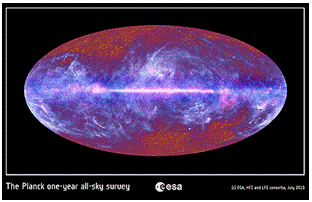 | Figure 3. The microwave sky as seen by Planck (Figure Credit: European Space Agency) |
4. Near Perfect Black Body Spectrum
- The FIRAS instrument on the COBE satellite measured the spectrum of the cosmic microwave background[28] and found that the CMB spectrum is well described by a near perfect blackbody (Figure 4). The first FIRAS result[28], showed that the data perfectly follows a blackbody spectrum with the temperature 2.735 ± 0.060 K. Mather et al[29] later published the CMB temperature to be 2.726 ± 0.01. This was later corrected for the FIRAS calibrator errors to give a temperature of 2.725 ± 0.002 K[30].
 , where
, where  is the current CMB temperature.The black-body nature of the CMB spectrum has been investigated and confirmed for a wide range of frequencies. A brief account of these developments can be found in[31]. Reference[32] summarizes most of the recent precision estimates of the CMB temperature made with a variety of methods from different platforms and wide range of frequencies. Combining all of the estimated results leads to an improved absolute temperature estimation of 2.72548 ± 0.00057 K[32].
is the current CMB temperature.The black-body nature of the CMB spectrum has been investigated and confirmed for a wide range of frequencies. A brief account of these developments can be found in[31]. Reference[32] summarizes most of the recent precision estimates of the CMB temperature made with a variety of methods from different platforms and wide range of frequencies. Combining all of the estimated results leads to an improved absolute temperature estimation of 2.72548 ± 0.00057 K[32]. 5. CMB Temperature Anisotropies
- Besides the black body CMB spectrum, the other cornerstone of Big Bang Cosmology was the prediction of anisotropies (variation in temperature from one part of the microwave sky to another) in the cosmic microwave background. After initial failures, the COBE’s DMR instrument first detected these anisotropies at the level of 1 part in 105[1]. Since these temperature anisotropies are related to the density fluctuations, CMB anisotropy reveals a wealth of information about the origin and evolution of the structures (Galaxies, Clusters etc) that we see in the Universe today. The origin of structures that we see today is still being debated. However, a very simple and plausible explanation is as follows: Structures formed because gravity pulled together matter that existed originally in slightly denser regions. Given the attractive nature of gravitational force, more and more matter was pulled in with the passage of time making compressed and denser structures until galaxies and other objects resulted. These objects resist further collapse because of their rotation and/or internal motions. While as it is widely believed that this “gravitational instability” is responsible for the formation of structures that we see today, it requires small initial density fluctuations to start the process of collapse. These density fluctuations are imprinted on the CMB temperature anisotropies. Owing to the significance of an accurate measurement of these anisotropies, a number of ground based balloon borne and satellite experiments were performed (some in progress) so as to measure these anisotropies with improved angular resolution and sensitivity. In section 3, we have briefly described as to how the satellite experiments improved our understanding of cosmology. These anisotropies can be expressed by using a spherical harmonic expansion of the CMB sky:
 | (1) |
 Smaller values of l correspond to larger angular scales. For example,
Smaller values of l correspond to larger angular scales. For example,  is the average value of T over the whole sky. Practically the monopole,
is the average value of T over the whole sky. Practically the monopole,  , determines the overall amplitude and does not contribute to the anisotropies.
, determines the overall amplitude and does not contribute to the anisotropies.  has an angular scale of
has an angular scale of  and is the angular dipole.
and is the angular dipole.  is the quadrapole and so on. The choice for an expansion in terms of spherical harmonics is logical since we expect the last scattering surface to be spherical.The inflationary models suggest that the temperature anisotropies should obey Gaussian statistics. In that case, all the statistical properties of the temperature anisotropies can be computed from a single function of multipole l, the temperature power spectrum
is the quadrapole and so on. The choice for an expansion in terms of spherical harmonics is logical since we expect the last scattering surface to be spherical.The inflationary models suggest that the temperature anisotropies should obey Gaussian statistics. In that case, all the statistical properties of the temperature anisotropies can be computed from a single function of multipole l, the temperature power spectrum Usually the quantity
Usually the quantity is plotted as a function of the multipole l. The improved resolution anisotropy map of the sky as observed by WMAP (7 year) is shown in figure (5).
is plotted as a function of the multipole l. The improved resolution anisotropy map of the sky as observed by WMAP (7 year) is shown in figure (5). 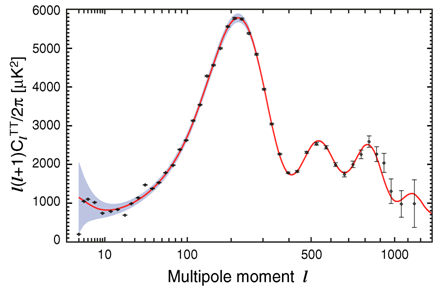 | Figure 5. The 7-year temperature (TT) power spectrum from WMAP. The grey band represents cosmic variance. (Figure credit: WMAP science team) |
 , rises to a clear peak at
, rises to a clear peak at  , followed by a lower amplitude second peak, third peak, higher order peaks and a damping tail. These peaks in the power spectrum are called “Acoustic Peaks”. The positions and magnitudes of the peaks contain fundamental properties about the geometry and structure of the Universe. For example, the first peak tells us that the curvature of the Universe is close to “flat”. The reason for this peak is that sound waves of the right frequency would have had just enough time to reach maximum compression when the Universe became transparent. The ratio of second to first peak amplitude gives the ratio of the baryon density to the critical closure density. The result from the WMAP 7 year data[2] is
, followed by a lower amplitude second peak, third peak, higher order peaks and a damping tail. These peaks in the power spectrum are called “Acoustic Peaks”. The positions and magnitudes of the peaks contain fundamental properties about the geometry and structure of the Universe. For example, the first peak tells us that the curvature of the Universe is close to “flat”. The reason for this peak is that sound waves of the right frequency would have had just enough time to reach maximum compression when the Universe became transparent. The ratio of second to first peak amplitude gives the ratio of the baryon density to the critical closure density. The result from the WMAP 7 year data[2] is . The third acoustic peak and the onset of the Silk damping tail are now well measured by WMAP. The third peak helps us to estimate the total matter density relative to critical density from which it follows that the Dark Matter density is
. The third acoustic peak and the onset of the Silk damping tail are now well measured by WMAP. The third peak helps us to estimate the total matter density relative to critical density from which it follows that the Dark Matter density is  [2]. Various other cosmological parameters are listed in[2]. PLANCK is expected to measure higher order peaks (including the damping tail) to better precision.While this paper was being reviewed, the WMAP 9-year results were also published [33-35]. This latest and final WMAP release shows that when WMAP data are combined with measurements of the high-l cosmic microwave background anisotropy, the baryon acoustic oscillation scale and the Hubble constant, the matter and energy densities, are each determined to a precision of nearly 1.5%. The amplitude of the primordial spectrum is measured to within 3%, and there is new evidence for a tilt in the primordial spectrum confirming the first detection of tilt based on the five-year WMAP data. While the WMAP mission comes to an end with the nine-year data, the scientific outcome of the mission can be ascertained by the fact that WMAP has decreased the allowable volume of the six-dimensional Lambda-CDM parameter space by a factor of 68,000 relative to pre-WMAP measurements, thereby converting cosmology from a field of wild speculation to a precision science.
[2]. Various other cosmological parameters are listed in[2]. PLANCK is expected to measure higher order peaks (including the damping tail) to better precision.While this paper was being reviewed, the WMAP 9-year results were also published [33-35]. This latest and final WMAP release shows that when WMAP data are combined with measurements of the high-l cosmic microwave background anisotropy, the baryon acoustic oscillation scale and the Hubble constant, the matter and energy densities, are each determined to a precision of nearly 1.5%. The amplitude of the primordial spectrum is measured to within 3%, and there is new evidence for a tilt in the primordial spectrum confirming the first detection of tilt based on the five-year WMAP data. While the WMAP mission comes to an end with the nine-year data, the scientific outcome of the mission can be ascertained by the fact that WMAP has decreased the allowable volume of the six-dimensional Lambda-CDM parameter space by a factor of 68,000 relative to pre-WMAP measurements, thereby converting cosmology from a field of wild speculation to a precision science.6. Discussion
- The cosmic microwave background, since its discovery, has been one of the most informative observable of the Universe. Results from experiments like BOOMERANG, MAXIMA, ARCHEOPS, CBI, DASI, WMAP and now PLANCK have taken the field into the era of precision cosmology. These studies have produced impressive constraints on many fundamental cosmic parameters and have led to a very definite picture of the structure and evolution of the Universe.In addition to lending a strong support to the Big Bang scenario and precise estimation of the cosmological parameters, the CMB has taught us that the Universe recombined at
 and started to become ionized again at
and started to become ionized again at  . Further, CMB reveals that the geometry of the Universe is close to flat and is dominated by Dark Matter and Dark Energy. It also tells us that gravitational instability is sufficient to grow all of the observed large structures in the Universe and that the initial perturbations were adiabatic in nature.Though CMB has been successful in giving cosmology the status of precision science, there are still many unsolved problems in cosmology which require a more systematic exploration and for which another generation of satellite experiments, as well as ground based and balloon-borne experiments, are required. In particular, unresolved questions connected with the early Universe include: the origin of dark energy that appears to be causing the Universe to accelerate, the nature of the dark matter that dominates the present matter density, the physics behind inflation, the truth about non-guassanity, the beginning of the universe. Possible answers to these questions are still highly speculative but precision CMB measurements are, indeed, the most promising empirical probe of the fundamental physics of the early Universe.CMB temperature anisotropies are now very well understood and Planck is expected to make the final temperature anisotropy measurements. The focus has now shifted to the polarization measurements. In this direction, the European Space Agency (ESA) is contemplating an All Sky Cosmic Background Polarization Mapper as a potential mission for its long term programme starting in 2015. A similar mission is in the agenda of NASA's Beyond Einstein programme. The Centre National d’Etudes Spatiales (CNES), a space agency in France, has supported an assessment study of SAMPAN (SAtellite to Measure the Polarized ANisotropies). Many other nations have programmes specifically aimed to look for the CMB polarization. The next decade is expected to be more exciting for CMB Cosmology and we hope to develop a better understanding of our universe.
. Further, CMB reveals that the geometry of the Universe is close to flat and is dominated by Dark Matter and Dark Energy. It also tells us that gravitational instability is sufficient to grow all of the observed large structures in the Universe and that the initial perturbations were adiabatic in nature.Though CMB has been successful in giving cosmology the status of precision science, there are still many unsolved problems in cosmology which require a more systematic exploration and for which another generation of satellite experiments, as well as ground based and balloon-borne experiments, are required. In particular, unresolved questions connected with the early Universe include: the origin of dark energy that appears to be causing the Universe to accelerate, the nature of the dark matter that dominates the present matter density, the physics behind inflation, the truth about non-guassanity, the beginning of the universe. Possible answers to these questions are still highly speculative but precision CMB measurements are, indeed, the most promising empirical probe of the fundamental physics of the early Universe.CMB temperature anisotropies are now very well understood and Planck is expected to make the final temperature anisotropy measurements. The focus has now shifted to the polarization measurements. In this direction, the European Space Agency (ESA) is contemplating an All Sky Cosmic Background Polarization Mapper as a potential mission for its long term programme starting in 2015. A similar mission is in the agenda of NASA's Beyond Einstein programme. The Centre National d’Etudes Spatiales (CNES), a space agency in France, has supported an assessment study of SAMPAN (SAtellite to Measure the Polarized ANisotropies). Many other nations have programmes specifically aimed to look for the CMB polarization. The next decade is expected to be more exciting for CMB Cosmology and we hope to develop a better understanding of our universe.ACKNOWLEDGEMENTS
- The author would like to thank Professor Tarun Sourdeep (IUCAA, India) for valuable discussions. The author acknowledges the project grant (No. SR/S2/HEP-92/2012) sanctioned by Department of Science and Technology, New Delhi.
 Abstract
Abstract Reference
Reference Full-Text PDF
Full-Text PDF Full-text HTML
Full-text HTML